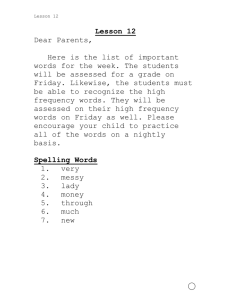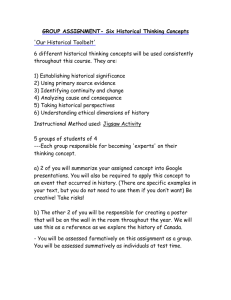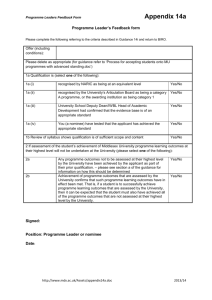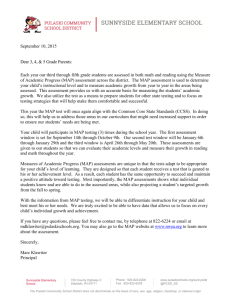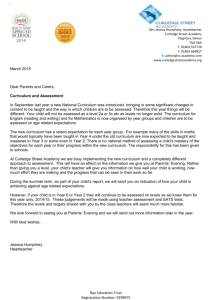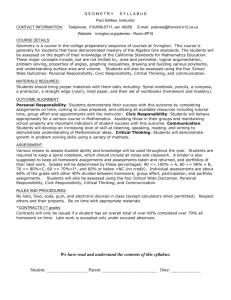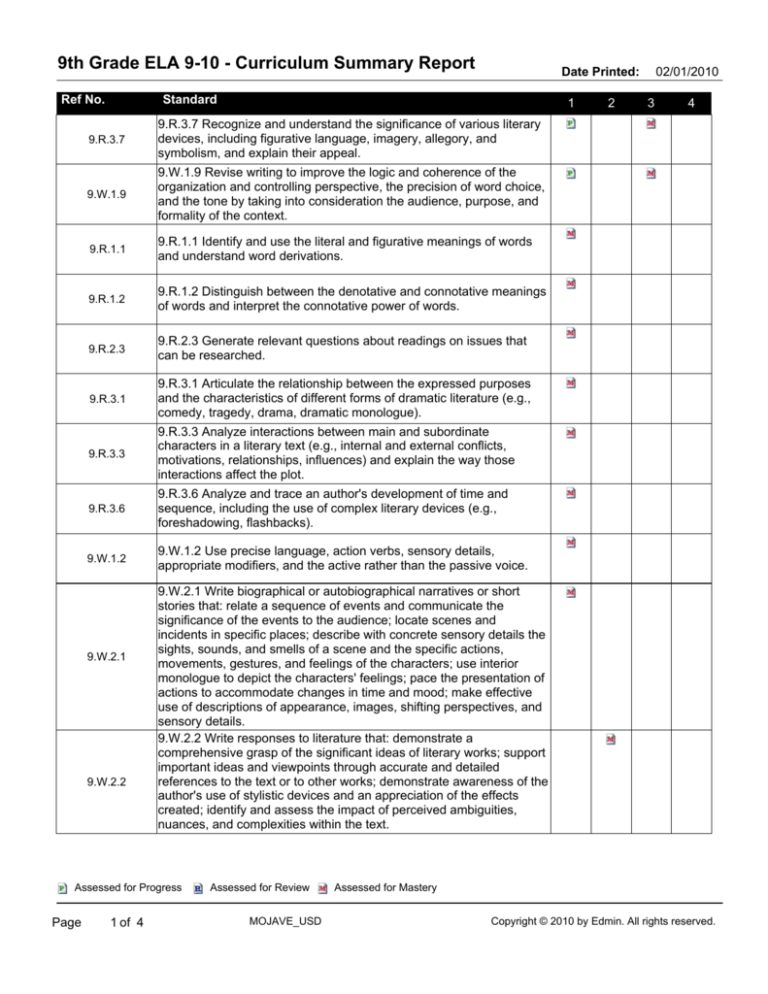
9th Grade ELA 9-10 - Curriculum Summary Report
Ref No.
Standard
1
9.R.3.7
9.R.3.7 Recognize and understand the significance of various literary
devices, including figurative language, imagery, allegory, and
symbolism, and explain their appeal.
9.W.1.9
9.W.1.9 Revise writing to improve the logic and coherence of the
organization and controlling perspective, the precision of word choice,
and the tone by taking into consideration the audience, purpose, and
formality of the context.
9.R.1.1
9.R.1.1 Identify and use the literal and figurative meanings of words
and understand word derivations.
9.R.1.2
9.R.1.2 Distinguish between the denotative and connotative meanings
of words and interpret the connotative power of words.
9.R.2.3
9.R.2.3 Generate relevant questions about readings on issues that
can be researched.
9.R.3.1
9.R.3.1 Articulate the relationship between the expressed purposes
and the characteristics of different forms of dramatic literature (e.g.,
comedy, tragedy, drama, dramatic monologue).
9.R.3.3
9.R.3.3 Analyze interactions between main and subordinate
characters in a literary text (e.g., internal and external conflicts,
motivations, relationships, influences) and explain the way those
interactions affect the plot.
9.R.3.6
9.R.3.6 Analyze and trace an author's development of time and
sequence, including the use of complex literary devices (e.g.,
foreshadowing, flashbacks).
9.W.1.2
9.W.1.2 Use precise language, action verbs, sensory details,
appropriate modifiers, and the active rather than the passive voice.
9.W.2.1
9.W.2.2
1 of 4
2
02/01/2010
3
4
9.W.2.1 Write biographical or autobiographical narratives or short
stories that: relate a sequence of events and communicate the
significance of the events to the audience; locate scenes and
incidents in specific places; describe with concrete sensory details the
sights, sounds, and smells of a scene and the specific actions,
movements, gestures, and feelings of the characters; use interior
monologue to depict the characters' feelings; pace the presentation of
actions to accommodate changes in time and mood; make effective
use of descriptions of appearance, images, shifting perspectives, and
sensory details.
9.W.2.2 Write responses to literature that: demonstrate a
comprehensive grasp of the significant ideas of literary works; support
important ideas and viewpoints through accurate and detailed
references to the text or to other works; demonstrate awareness of the
author's use of stylistic devices and an appreciation of the effects
created; identify and assess the impact of perceived ambiguities,
nuances, and complexities within the text.
Assessed for Progress
Page
Date Printed:
Assessed for Review
MOJAVE_USD
Assessed for Mastery
Copyright © 2010 by Edmin. All rights reserved.
9th Grade ELA 9-10 - Curriculum Summary Report
Ref No.
Standard
1
9.R.3.8
9.R.3.8 Interpret and evaluate the impact of ambiguities, subtleties,
contradictions, ironies, and incongruities in a text.
9.R.3.9
9.R.3.9 Explain how voice, persona, and the choice of a narrator
affect characterization and the tone, plot, and credibility of a text.
9.R.3.10
9.R.3.10 Identify and describe the function of dialogue, scene designs,
soliloquies, asides, and character foils in dramatic literature.
9.R.3.4
9.R.3.4 Determine characters' traits by what the characters say about
themselves in narration, dialogue, dramatic monologue, and soliloquy.
9.R.3.5
9.R.3.5 Compare works that express a universal theme and provide
evidence to support the ideas expressed in each work.
9.R.3.2
9.R.3.2 Compare and contrast the presentation of a similar theme or
topic across genres to explain how the selection of genre shapes the
theme or topic.
9.R.2.8
9.R.2.8 Evaluate the credibility of an author's argument or defense of
a claim by critiquing the relationship between generalizations and
evidence, the comprehensiveness of evidence, and the way in which
the author's intent affects the structure and tone of the text (e.g., in
professional journals, editorials, political speeches, primary source
material).
9.R.1.3
9.R.1.3 Identify Greek, Roman, and Norse mythology and use the
knowledge to understand the origin and meaning of new words (e.g.,
the word narcissistic drawn from the myth of Narcissus and Echo).
9.R.2.4
9.R.2.4 Synthesize the content from several sources or works by a
single author dealing with a single issue; paraphrase the ideas and
connect them to other sources and related topics to demonstrate
comprehension.
9.R.2.5
9.R.2.5 Extend ideas presented in primary or secondary sources
through original analysis, evaluation, and elaboration.
9.R.2.6
9.R.2.6 Demonstrate use of sophisticated learning tools by following
technical directions (e.g., those found with graphic calculators and
specialized software programs and in access guides to World Wide
Web sites on the Internet).
9.R.2.2
9.R.2.2 Prepare a bibliography of reference materials for a report
using a variety of consumer, workplace, and public documents.
9.R.3.11
9.R.3.11 Evaluate the aesthetic qualities of style, including the impact
of diction and figurative language on tone, mood, and theme, using
the terminology of literary criticism. (Aesthetic approach)
Assessed for Progress
Page
Date Printed:
2 of 4
Assessed for Review
MOJAVE_USD
2
02/01/2010
3
4
Assessed for Mastery
Copyright © 2010 by Edmin. All rights reserved.
9th Grade ELA 9-10 - Curriculum Summary Report
Ref No.
Standard
1
9.R.3.12
9.R.3.12 Analyze the way in which a work of literature is related to the
themes and issues of its historical period. (Historical approach)
9.W.1.1
9.W.1.1 Establish a controlling impression or coherent thesis that
conveys a clear and distinctive perspective on the subject and
maintain a consistent tone and focus throughout the piece of writing.
9.W.2.3
9.W.2.3 Write expository compositions, including analytical essays
and research reports that: marshal evidence in support of a thesis and
related claims, including information on all relevant perspectives;
convey information and ideas from primary and secondary sources
accurately and coherently; make distinctions between the relative
value and significance of specific data, facts, and ideas; Include visual
aids by employing appropriate technology to organize and record
information on charts, maps, and graphs; include visual aids by
employing appropriate technology to organize and record information
on charts, maps, and graphs; use technical terms and notations
accurately.
9.W.1.3
9.W.1.3 Use clear research questions and suitable research methods
(e.g., library, electronic media, personal interview) to elicit and present
evidence from primary and secondary sources.
9.W.1.4
9.W.1.4 Develop the main ideas within the body of the composition
through supporting evidence (e.g., scenarios, commonly held beliefs,
hypotheses, definitions).
9.W.1.5
9.C.1.1
9.C.1.2
9.C.1.5
9.W.2.4
3 of 4
2
02/01/2010
3
4
9.W.1.5 Synthesize information from multiple sources and identify
complexities and discrepancies in the information and the different
perspectives found in each medium (e.g., almanacs, microfiche, news
sources, in-depth field studies, speeches, journals, technical
documents).
9.C.1.1 Identify and correctly use clauses (e.g., main and
subordinate), phrases (e.g., gerund, infinitive, and participial), and
mechanics of punctuation (e.g., semicolons, colons, ellipses,
hyphens).
9.C.1.2 Understand sentence construction (e.g., parallel structure,
subordination, proper placement of modifiers) and proper English
usage (e.g., consistency of verb tenses).
9.C.1.5 Reflect appropriate manuscript requirements, including title
page presentation, pagination, spacing and margins, and integration
of source and support material (e.g., in-text citation, use of direct
quotations, paraphrasing) with appropriate citations.
9.W.2.4 Write persuasive compositions that: use technical terms and
notations accurately; use specific rhetorical devices to support
assertions (e.g., appeal to logic through reasoning; appeal to emotion
or ethical belief; relate a personal anecdote, case study, or analogy);
clarify and defend positions with precise and relevant evidence,
including facts, expert opinions, quotations, and expressions of
commonly accepted beliefs and logical reasoning; address readers'
concerns, counterclaims, biases, and expectations.
Assessed for Progress
Page
Date Printed:
Assessed for Review
MOJAVE_USD
Assessed for Mastery
Copyright © 2010 by Edmin. All rights reserved.
9th Grade ELA 9-10 - Curriculum Summary Report
Ref No.
Standard
1
9.C.1.4
9.C.1.4 Produce legible work that shows accurate spelling and correct
use of the conventions of punctuation and capitalization.
9.R.2.7
9.R.2.7 Critique the logic of functional documents by examining the
sequence of information and procedures in anticipation of possible
reader misunderstandings.
9.R.2.1
9.R.2.1 Analyze the structure and format of functional workplace
documents, including the graphics and headers, and explain how
authors use the features to achieve their purposes.
Assessed for Progress
Page
Date Printed:
4 of 4
Assessed for Review
MOJAVE_USD
2
02/01/2010
3
4
Assessed for Mastery
Copyright © 2010 by Edmin. All rights reserved.


